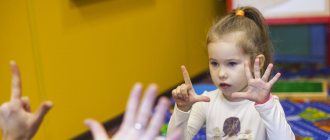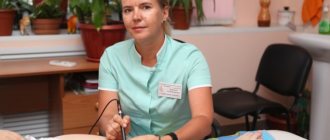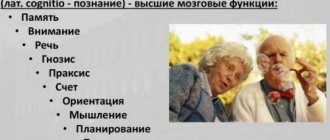Article on the topic: “Types and characteristics of perception in children.”
Types and characteristics of perception in children
Our brain interprets the surrounding reality and receives useful information from it. Each of us has an optimal way of receiving information. Understanding how our child perceives information will help us develop his learning abilities. Research shows that 20-30% of people remember information through hearing, 40% through vision, and the rest remember best when they write down what they hear or apply the acquired knowledge in practice.
Types of perception
There are three types of perception - visual, auditory and kinesthetic (tactile). Organized children who love to read and notice details are visual types. Children who have well-developed speech skills, a penchant for learning foreign languages and musical talents belong to the auditory type. Children who like to act out and be physically active, use body language to explain things, and like to write are kinesthetic types. By observing a child, you can determine his type of perception - this will help parents and teachers maximize the use of different parts of the child’s brain in the process of his learning.
Children with visual
perception
Children with a visual type of perception like to see the big picture of what is happening. They need the information to be presented in an attractive manner. They have well-developed visualization skills. These children should be exposed to fun activities that engage their speaking and reading skills. Link these activities to your child's learning by developing their vocabulary and pronunciation to improve their performance in school.
- Give your child a list of nouns, verbs, adjectives and pronouns that you will use in class. If at school your child is given a task to learn any words, add them to the list. Let your child choose colors for each group of words. Write the words on different colored cards.
- Invite your child to sort the cards by color.
- Invite your child to make sentences or coherent text from the words. This will teach a visual child to see the big picture and the end goal of the lesson.
- When your child can make sentences out of words, encourage him to make a story using all the words.
- Involve kinesthetic and auditory perception in the learning process: invite him to read the story out loud and act out a skit based on it.
Children with auditory perception
Auditory children perceive information better when something is explained to them in detail. According to research, auditory learners often talk to themselves, like to explain things to others, and have difficulty remaining silent for long periods of time.
Use their desire to talk when teaching auditory children. Offer them activities that involve speaking and listening skills.
- Talk to your child about his favorite food. Let him tell you all the reasons why he likes a particular dish. Ask what it tastes like and how the child feels about it.
- Help your child find a recipe for this dish on the Internet or in a cookbook. Make a copy of the recipe for your class.
- Encourage your child to read the recipe aloud to develop their auditory comprehension.
- As your child reads the recipe, encourage him to circle the words he liked from the text with a colored marker.
- Encourage your child to measure out the required amount of ingredients to prepare the dish. Describe the entire process out loud.
- Before trying the food, give your child a pen and paper and encourage him to describe his cooking experience. Thus, his auditory perception will be combined with kinesthetic perception. If a child illustrates his text, the visual channel of perception will also be involved.
- Invite your child to serve the prepared dish to all family members. At the same time, he must tell how the dish was prepared and whether he liked cooking it.
Children with kinesthetic perception
Kinesthetic children cannot sit still and constantly play outdoor games. Children with kinesthetic perception are considered difficult students because they are too active. But in fact, for successful learning, you need to include movement in this process.
Use games to teach a kinaesthetic child. Combine gameplay with learning modules (which may include new words or historical dates). During the game, the child will better remember the material and also enjoy the game itself.
- Choose the names your child needs to learn and have him write them down on cards. It’s especially good to learn new words this way.
- When your child writes down the words, invite him to read them out loud and write them with his finger in the air or on the surface of the table - this way the brain remembers the information better. On the back of the cards write tasks: “show”, “draw” or “explain”.
- After this, give your child a short break so that he can better concentrate on the game.
- Prepare everything you need for the game: notebooks, pencils, markers, etc.
- Invite your child's friends or family members to play. Shuffle the cards and invite your child to draw one of them. He must show, draw or explain the word written on the card without saying it. The rest must guess what word is written on the card.
- Allow players to change until all the words have been guessed. If your child cannot sit still while someone else is playing, find a place in the room where he can move around without disturbing others.
Understanding your child's perceptual characteristics gives you additional opportunities to find the optimal way for him to learn without exposing him to frustration. Use activities that work best for your child. This will help him learn better and strengthen your bond with him.
Psychophysiological bases of perception of the sound-symbolic component of words
The material basis of the phenomenon of sound symbolism and the arbitrariness of the linguistic sign Read more: Sound symbolism and motivation
2.3 Psychophysiological bases of perception of the sound-symbolic component of words
Man has a rather complex apparatus for perceiving sounds. Sound vibrations are collected by the auricle and act on the eardrum through the auditory canal. Vibrations of the latter are transmitted through a system of small bones to a second elastic membrane, the so-called oval window, which closes a small cavity of the cochlea filled with fluid (lymph). Inside the cochlea there are a large number of special fibers that have different lengths and tensions, and, consequently, different natural frequencies of vibration. When exposed to a complex sound, each of these fibers resonates to that component tone, the frequency of which coincides with the natural frequency of the fiber, and irritates the corresponding ending of the auditory nerve.
Sensory signals carry external information to the brain necessary for orientation in the external environment. These signals arise in the perceiving elements (receptors) and are transmitted to the brain through chains of neurons and the fibers of the sensory system connecting them. The process of transmitting sensory signals is accompanied by their repeated transformation and recoding at all levels of the sensory system and ends with the recognition of a sensory image.
We used such a complex explanation of the process of perception and decoding of sound signals to more clearly illustrate this process, as well as to facilitate the determination of the stage of this process at which the sound-symbolic component of a word begins to play an active role.
Researchers in the field of psychophysiology identify the following functions of the nervous system: detection of signals and their discrimination, transmission, transformation and coding, as well as detection of signs of a sensory image and its recognition. In accordance with these functions, we can distinguish the corresponding stages of the process of perception and decoding of sound.
It is clear that the first three stages: detection of signals, their discrimination and transmission are of a purely psychophysiological, physical nature, where sound waves are recorded by the human hearing aid and are distinguished as sounds that have corresponding physical characteristics.
At the last stage (pattern recognition) - the final and most complex operation of the sensory system, which represents the assignment of an image to a particular class of objects that the organism has previously encountered, i.e. classification of images - the image already seems “complete”, “whole” with all the sound-symbolic or other associations that have arisen. By synthesizing signals from detector neurons, the higher department of the sensory system forms an “image” of the stimulus and compares it with many images stored in memory. At the same time, although the image has not yet been identified, sound-symbolic associations (if the word is sound-symbolic) have already arisen, and, thus, the identification process is easier, faster and more effective on the basis of an already existing “hint” - a sound-symbolic association.
Consequently, the sound-symbolic association arises somewhere at the intermediate stages - transformation, or encoding, and decoding of the signal.
Coding is the transformation of information into a conditional form, a code, carried out according to certain rules. The peculiarity of this process is that, unlike telephone and television codes, decoding restores the signal not in its original form, but in a slightly modified one. Decoding signals is the selective selection by sensory neurons of one or another sign of a stimulus that has behavioral significance. This analysis is carried out by detector neurons that selectively respond only to certain properties of the stimulus (first-order detectors). Higher-order detectors responsible for identifying complex features and entire images are concentrated in the higher parts of the sensory system. It can be assumed, accordingly, that the sound-symbolic component in the corresponding words is preserved during encoding, restored during decoding and is highlighted as a corresponding feature by first-order detectors (it is at this stage that it generates certain associations, creating a “premonition” of the image) “helping”, accordingly, higher-order detectors It is easier and more effective to isolate an entire image or its complex feature. (It is also interesting in this regard to mention the following observation: when conducting experiments, the author of this work discovered that associations, even to unfamiliar foreign words, arose in the subjects faster if the words contained a sound-symbolic component, which confirms the hypothesis put forward above).
An interesting feature of the decoding and recognition process is that errors are possible when recognizing sensory images. A special group of them are called “sensory illusions.” They are based on some side effects of the interaction of neurons involved in signal processing, and lead to a distorted assessment of the image as a whole or its individual characteristics. Therefore, we can make the following assumption: sound-symbolic words that have an appropriate sound-symbolic component are less susceptible to errors during decoding and recognition, because the corresponding phonetic-semantic component is an “amplifier”, through which it is easier to restore the original form of the word, even if part of it was lost during the recognition process due to external or other interference.
The most important components of the psychophysiological basis of sound symbolism are synesthesia and kinemics. Synesthesia is a perceptual phenomenon in which an impression corresponding to a given stimulus and specific to a given sense organ is accompanied by an additional sensation or image, often characteristic of another modality. It is this phenomenon, as many researchers believe, that underlies the phenomenon of sound symbolism (the theory of transposition of sensations). Kinematics is a set of involuntary muscle movements that accompany sensations and emotions. As researchers of this issue believe, this phenomenon served as one of the sources of the formation of the sound-visual proto-language. Thus, these phenomena can be considered the basis for the production of sound-symbolic words and their perception by humans.
The material basis of the phenomenon of sound symbolism and the arbitrariness of the linguistic sign Read more: Sound symbolism and motivation
Information about the work “Objective conditioning of the perception of sound-symbolic words of a language and the connection between the phonetic form of a word and its semantic content and denotation”
Section: Literature and Russian language Number of characters with spaces: 109480 Number of tables: 0 Number of images: 0
Classification of perception by leading analyzers
The process of perception usually occurs with the help of a number of interacting analyzers, but one of them always plays a leading role. On this basis, the following types of perception are distinguished: auditory, visual, tactile, olfactory, kinesthetic and gustatory.
In visual perception, the leading role is played by the visual analyzer, but the motor analyzer is also involved. Analysis of the perceptual actions of the eye showed that eye movements can be divided into two types: micromovements and macromovements. Using micro-movements, the image moves to neighboring points on the retina. They are important for maintaining image stability. Research by A.L. Yarbus has shown that the motionless eye can retain the image of an object for only a very short period of time, after which the image disappears and the person begins to see an “empty field.” To prove this, the cornea of the eye was secured with a suction cup, on which a luminous loop was installed. This loop moved along with the movements of the eye, and as a result remained motionless relative to the eye, and its image always fell on the same part of the retina. The subject clearly saw the image of the loop for only 1-2 s, after which the image disappeared. There is reason to believe that this is due to extreme excitation of this area, which leads to its functional shutdown.
Macro eye movements can be jerky (saccadic) and smooth (drifting). These movements make it possible to consistently identify the most informative features of an object, compare them with each other and synthesize the final set of features necessary for recognizing the object. Motor components of perception are not given to a person from birth. They are formed throughout life. This is evidenced by data on the characteristics of visual perception of people born blind or who lost their sight in early childhood after their vision was restored. Observation of a man who became blind at 10 months of age and whose sight was restored at fifty-one years of age showed that after the operation, when the bandage was removed from the patient's eyes, he saw only blurry outlines. For some time after the operation, there was no objective world for him: even after a year, the patient could not distinguish complex objects, and they were further perceived by touch. Visual perception acquires particular importance when perceiving space.
Thanks to auditory perceptions, a person hears not individual sounds, but a melody, not individual phonemes, but words. Of particular importance is phonetic hearing, which is finally formed at 6-7 years of age. Starting at this age, the child should perceive differently words that differ in consonants (for example, bark-mountain) or loud sounds (for example, forest-fox). Without mastering the phonetic system of a language, our hearing remains unorganized and a person not only does not understand, but also does not hear individual sounds.
In auditory perception, in addition to the auditory analyzer, the choice of which is varied on the website hemomedica-distribution.com, motor perception is also involved. Thus, when perceiving speech, the text is spoken “to oneself”. If the information is familiar or easy to understand, then this pronunciation is somewhat reduced. The same can be said about the perception of melody. Auditory perception acquires particular importance in the perception of time.
The motor analyzer simultaneously with kinesthetic and tactile sensations is involved in the formation of the image of tactile perceptions. Analysis of hand actions showed that it is possible to distinguish two classes of hand movements, with the help of which a holistic image of an object (haptic image) is formed: micromovements of the fingers with an amplitude from 2 to 100 mm, which stop at “critical” ones, i.e. the most informative points of an object, as a result of which its individual features are highlighted; and macro-movements with an amplitude of more than 100 mm, as a result of which the already identified individual features are combined and the assumption about the perceived object is checked. As a result of exercises, as well as with tangential perception of familiar objects, the extensive process of palpation is shortened and it is enough to analyze only one informative sign to recognize the object.
Tactile perception acquires particular importance when perceiving space. The role of motor components in the process of visual, auditory, tactile and other types of perception gives grounds to assert that we cannot perceive before we have learned to perceive, because mastering the system of perceptual actions requires practice.










